 |
| September 03, 2024 | Volume 20 Issue 33 |
Mechanical News & Products
Designfax weekly eMagazine
Archives
Partners
Manufacturing Center
Product Spotlight
Modern Applications News
Metalworking Ideas For
Today's Job Shops
Tooling and Production
Strategies for large
metalworking plants
What's a SLIC Pin®? Pin and cotter all in one!
 The SLIC Pin (Self-Locking Implanted Cotter Pin) from Pivot Point is a pin and cotter all in one. This one-piece locking clevis pin is cost saving, fast, and secure. It functions as a quick locking pin wherever you need a fast-lock function. It features a spring-loaded plunger that functions as an easy insertion ramp. This revolutionary fastening pin is very popular and used successfully in a wide range of applications.
The SLIC Pin (Self-Locking Implanted Cotter Pin) from Pivot Point is a pin and cotter all in one. This one-piece locking clevis pin is cost saving, fast, and secure. It functions as a quick locking pin wherever you need a fast-lock function. It features a spring-loaded plunger that functions as an easy insertion ramp. This revolutionary fastening pin is very popular and used successfully in a wide range of applications.
Learn more.
Engineering challenge: Which 3D-printed parts will fade?
 How does prolonged exposure to intense UV light impact 3D-printed plastics? Will they fade? This is what Xometry's Director of Application Engineering, Greg Paulsen, set to find out. In this video, Paulsen performs comprehensive tests on samples manufactured using various additive processes, including FDM, SLS, SLA, PolyJet, DLS, and LSPc, to determine their UV resistance. Very informative. Some results may surprise you.
How does prolonged exposure to intense UV light impact 3D-printed plastics? Will they fade? This is what Xometry's Director of Application Engineering, Greg Paulsen, set to find out. In this video, Paulsen performs comprehensive tests on samples manufactured using various additive processes, including FDM, SLS, SLA, PolyJet, DLS, and LSPc, to determine their UV resistance. Very informative. Some results may surprise you.
View the video.
Copper filament for 3D printing
 Virtual Foundry, the company that brought us 3D-printable lunar regolith simulant, says its popular Copper Filamet™ (not a typo) is "back in stock and ready for your next project." This material is compatible with any open-architecture FDM/FFF 3D printer. After sintering, final parts are 100% pure copper. Also available as pellets. The company says this is one of the easiest materials to print and sinter. New Porcelain Filamet™ available too.
Virtual Foundry, the company that brought us 3D-printable lunar regolith simulant, says its popular Copper Filamet™ (not a typo) is "back in stock and ready for your next project." This material is compatible with any open-architecture FDM/FFF 3D printer. After sintering, final parts are 100% pure copper. Also available as pellets. The company says this is one of the easiest materials to print and sinter. New Porcelain Filamet™ available too.
Learn more and get all the specs.
Copper foam -- so many advantages
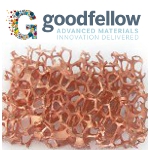 Copper foam from Goodfellow combines the outstanding thermal conductivity of copper with the structural benefits of a metal foam. These features are of particular interest to design engineers working in the fields of medical products and devices, defense systems and manned flight, power generation, and the manufacture of semiconductor devices. This product has a true skeletal structure with no voids, inclusions, or entrapments. A perennial favorite of Designfax readers.
Copper foam from Goodfellow combines the outstanding thermal conductivity of copper with the structural benefits of a metal foam. These features are of particular interest to design engineers working in the fields of medical products and devices, defense systems and manned flight, power generation, and the manufacture of semiconductor devices. This product has a true skeletal structure with no voids, inclusions, or entrapments. A perennial favorite of Designfax readers.
Learn more.
Full-color 3D-printing Design Guide from Xometry
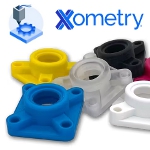 With Xometry's PolyJet 3D-printing service, you can order full-color 3D prints easily. Their no-cost design guide will help you learn about different aspects of 3D printing colorful parts, how to create and add color to your models, and best practices to keep in mind when printing in full color. Learn how to take full advantage of the 600,000 unique colors available in this flexible additive process.
With Xometry's PolyJet 3D-printing service, you can order full-color 3D prints easily. Their no-cost design guide will help you learn about different aspects of 3D printing colorful parts, how to create and add color to your models, and best practices to keep in mind when printing in full color. Learn how to take full advantage of the 600,000 unique colors available in this flexible additive process.
Get the Xometry guide.
Tech Tip: How to create high-quality STL files for 3D prints
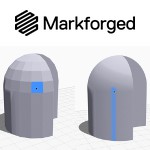 Have you ever 3D printed a part that had flat spots or faceted surfaces where smooth curves were supposed to be? You are not alone, and it's not your 3D printer's fault. According to Markforged, the culprit is likely a lack of resolution in the STL file used to create the part.
Have you ever 3D printed a part that had flat spots or faceted surfaces where smooth curves were supposed to be? You are not alone, and it's not your 3D printer's fault. According to Markforged, the culprit is likely a lack of resolution in the STL file used to create the part.
Read this detailed and informative Markforged blog.
Test your knowledge: High-temp adhesives
 Put your knowledge to the test by trying to answer these key questions on how to choose the right high-temperature-resistant adhesive. The technical experts from Master Bond cover critical information necessary for the selection process, including questions on glass transition temperature and service temperature range. Some of the answers may surprise even the savviest of engineers.
Put your knowledge to the test by trying to answer these key questions on how to choose the right high-temperature-resistant adhesive. The technical experts from Master Bond cover critical information necessary for the selection process, including questions on glass transition temperature and service temperature range. Some of the answers may surprise even the savviest of engineers.
Take the quiz.
Engineer's Toolbox: How to pin a shaft and hub assembly properly
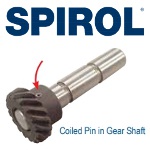 One of the primary benefits of using a coiled spring pin to affix a hub or gear to a shaft is the coiled pin's ability to prevent hole damage. Another is the coiled pin absorbs wider hole tolerances than any other press-fit pin. This translates to lower total manufacturing costs of the assembly. However, there are a few design guidelines that must be adhered to in order to achieve the maximum strength of the pinned system and prevent damage to the assembly.
One of the primary benefits of using a coiled spring pin to affix a hub or gear to a shaft is the coiled pin's ability to prevent hole damage. Another is the coiled pin absorbs wider hole tolerances than any other press-fit pin. This translates to lower total manufacturing costs of the assembly. However, there are a few design guidelines that must be adhered to in order to achieve the maximum strength of the pinned system and prevent damage to the assembly.
Read this very informative SPIROL article.
What's new in Creo Parametric 11.0?
 Creo Parametric 11.0 is packed with productivity-enhancing updates, and sometimes the smallest changes make the biggest impact in your daily workflows. Mark Potrzebowski, Technical Training Engineer, Rand 3D, runs through the newest functionality -- from improved surface modeling tools to smarter file management and model tree navigation. Videos provide extra instruction.
Creo Parametric 11.0 is packed with productivity-enhancing updates, and sometimes the smallest changes make the biggest impact in your daily workflows. Mark Potrzebowski, Technical Training Engineer, Rand 3D, runs through the newest functionality -- from improved surface modeling tools to smarter file management and model tree navigation. Videos provide extra instruction.
Read the full article.
What's so special about wave springs?
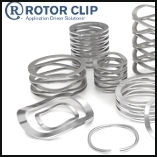 Don't settle for ordinary springs. Opt for Rotor Clip wave springs. A wave spring is a type of flat wire compression spring characterized by its unique waveform-like structure. Unlike traditional coil springs, wave springs offer an innovative solution to complex engineering challenges, producing forces from bending, not torsion. Their standout feature lies in their ability to compress and expand efficiently while occupying up to 50% less axial space than traditional compression springs. Experience the difference Rotor Clip wave springs can make in your applications today!
Don't settle for ordinary springs. Opt for Rotor Clip wave springs. A wave spring is a type of flat wire compression spring characterized by its unique waveform-like structure. Unlike traditional coil springs, wave springs offer an innovative solution to complex engineering challenges, producing forces from bending, not torsion. Their standout feature lies in their ability to compress and expand efficiently while occupying up to 50% less axial space than traditional compression springs. Experience the difference Rotor Clip wave springs can make in your applications today!
View the video.
New Standard Parts Handbook from JW Winco
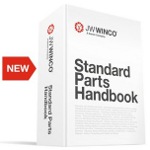 JW Winco's printed Standard Parts Handbook is a comprehensive 2,184-page reference that supports designers and engineers with the largest selection of standard parts categorized into three main groups: operating, clamping, and machine parts. More than 75,000 standard parts can be found in this valuable resource, including toggle clamps, shaft collars, concealed multiple-joint hinges, and hygienically designed components.
JW Winco's printed Standard Parts Handbook is a comprehensive 2,184-page reference that supports designers and engineers with the largest selection of standard parts categorized into three main groups: operating, clamping, and machine parts. More than 75,000 standard parts can be found in this valuable resource, including toggle clamps, shaft collars, concealed multiple-joint hinges, and hygienically designed components.
Get your Standard Parts Handbook today.
Looking to save space in your designs?
 Watch Smalley's quick explainer video to see how engineer Frank improved his product designs by switching from traditional coil springs to compact, efficient wave springs. Tasked with making his products smaller while keeping costs down, Frank found wave springs were the perfect solution.
Watch Smalley's quick explainer video to see how engineer Frank improved his product designs by switching from traditional coil springs to compact, efficient wave springs. Tasked with making his products smaller while keeping costs down, Frank found wave springs were the perfect solution.
View the video.
Top die casting design tips
 You can improve the design and cost of your die cast parts with these top tips from Xometry's Joel Schadegg. Topics include: Fillets and Radii, Wall Thicknesses, Ribs and Metal Savers, Holes and Windows, Parting Lines, and more. Follow these recommendations so you have the highest chance of success with your project.
You can improve the design and cost of your die cast parts with these top tips from Xometry's Joel Schadegg. Topics include: Fillets and Radii, Wall Thicknesses, Ribs and Metal Savers, Holes and Windows, Parting Lines, and more. Follow these recommendations so you have the highest chance of success with your project.
Read the full Xometry article.
What's the latest from 3D Systems? Innovations for different industries, processes
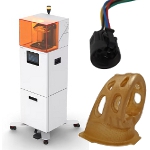 3D Systems unveiled several new solutions at the RAPID+TCT 2025 show in April designed to change the way industries innovate. From new 3D printers and materials for high-mix, low-volume applications to marked improvements in how investment casting can be done, learn what is the state of the art from the original inventors of 3D printing.
3D Systems unveiled several new solutions at the RAPID+TCT 2025 show in April designed to change the way industries innovate. From new 3D printers and materials for high-mix, low-volume applications to marked improvements in how investment casting can be done, learn what is the state of the art from the original inventors of 3D printing.
Read the full article.
Clever! Indexing plungers with chamfered pins
 JW Winco has developed a new type of indexing plunger -- GN 824 -- that can independently latch into edges and grooves. This is made possible by a chamfered plunger pin. When the chamfered pin encounters a raised latching geometry, it retracts and then springs back out again once it reaches the latching point. This new indexing plunger can be ordered with axial thread for fastening and a black plastic knob for operating the indexing plunger. In a clever design, the plunger pin can be adjusted by 360 degrees to ensure that it encounters the mating surface perpendicularly. This hardware is well suited for transport frames, mechanisms, or covers that need to be locked in place quickly and securely, especially without the need for manual intervention.
JW Winco has developed a new type of indexing plunger -- GN 824 -- that can independently latch into edges and grooves. This is made possible by a chamfered plunger pin. When the chamfered pin encounters a raised latching geometry, it retracts and then springs back out again once it reaches the latching point. This new indexing plunger can be ordered with axial thread for fastening and a black plastic knob for operating the indexing plunger. In a clever design, the plunger pin can be adjusted by 360 degrees to ensure that it encounters the mating surface perpendicularly. This hardware is well suited for transport frames, mechanisms, or covers that need to be locked in place quickly and securely, especially without the need for manual intervention.
Learn more.
Eye-opener: Almost half of FDA-approved AI medical devices are not trained on real patient data
By Kendall Daniels, University of North Carolina Health Care
Artificial intelligence (AI) has practically limitless applications in healthcare, ranging from auto-drafting patient messages in MyChart to optimizing organ transplantation and improving tumor removal accuracy. Despite their potential benefit to doctors and patients alike, these tools have been met with skepticism because of patient privacy concerns, the possibility of bias, and device accuracy.
In response to the rapidly evolving use and approval of AI medical devices in healthcare, a multi-institutional team of researchers at the University of North Carolina (UNC) School of Medicine, Duke University, Ally Bank, Oxford University, Colombia University, and University of Miami have been on a mission to build public trust and evaluate how exactly AI and algorithmic technologies are being approved for use in patient care.
Together, Sammy Chouffani El Fassi, an MD candidate at the UNC School of Medicine and research scholar at Duke Heart Center, and Gail E. Henderson, PhD, professor at the UNC Department of Social Medicine, led a thorough analysis of clinical validation data for 500+ medical AI devices, revealing that approximately half of the tools authorized by the U.S. Food and Drug Administration (FDA) lacked reported clinical validation data. Their findings were published in Nature Medicine.
"Although AI device manufacturers boast of the credibility of their technology with FDA authorization, clearance does not mean that the devices have been properly evaluated for clinical effectiveness using real patient data," said Chouffani El Fassi, who was first author on the paper. "With these findings, we hope to encourage the FDA and industry to boost the credibility of device authorization by conducting clinical validation studies on these technologies and making the results of such studies publicly available."
Since 2016, the average number of medical AI device authorizations by the FDA per year has increased from 2 to 69, indicating tremendous growth in commercialization of AI medical technologies. The majority of approved AI medical technologies are being used to assist physicians with diagnosing abnormalities in radiological imaging, pathologic slide analysis, dosing medicine, and predicting disease progression.
Artificial intelligence is able to learn and perform such human-like functions by using combinations of algorithms. The technology is then given a plethora of data and sets of rules to follow, so that it can "learn" how to detect patterns and relationships with ease. From there, the device manufacturers need to ensure that the technology does not simply memorize the data previously used to train the AI, and that it can accurately produce results using never-before-seen solutions.
Regulation during a rapid proliferation of AI medical devices
Following the rapid proliferation of these devices and applications to the FDA, Chouffani El Fassi and Henderson et al. were curious about how clinically effective and safe the authorized devices are. Their team analyzed all submissions available on the FDA's official database, titled "Artificial Intelligence and Machine Learning (AI/ML)-Enabled Medical Devices."
"A lot of the devices that came out after 2016 were created new, or maybe they were similar to a product that already was on the market," said Henderson. "Using these hundreds of devices in this database, we wanted to determine what it really means for an AI medical device to be FDA authorized."
Of the 521 device authorizations, 144 were labelled as "retrospectively validated," 148 were "prospectively validated," and 22 were validated using randomized controlled trials. Most notably, 226 of 521 FDA-approved medical devices, or approximately 43%, lacked published clinical validation data. A few of the devices used "phantom images" or computer-generated images that were not from a real patient, which did not technically meet the requirements for clinical validation.
Furthermore, the researchers found that the latest draft guidance, published by the FDA in September 2023, does not clearly distinguish between different types of clinical validation studies in its recommendations to manufacturers.
Types of clinical validation and a new standard
In the realm of clinical validation, there are three different methods by which researchers and device manufacturers validate the accuracy of their technologies: retrospective validation, prospective validation, and subset of prospective validation (called randomized controlled trials).
Retrospective validation involves feeding the AI model image data from the past, such as patient chest x-rays prior to the COVID-19 pandemic. Prospective validation, however, typically produces stronger scientific evidence, because the AI device is being validated based on real-time data from patients. This is more realistic, according to the researchers, because it allows the AI to account for data variables that were not in existence when it was being trained, such as patient chest X-rays that were impacted by viruses during the COVID pandemic.
Randomized controlled trials are considered the gold standard for clinical validation. This type of prospective study utilizes random assignment controls for confounding variables that would differentiate the experimental and control groups, thus isolating the therapeutic effect of the device. For example, researchers could evaluate device performance by randomly assigning patients to have their CT scans read by a radiologist (control group) versus AI (experimental group).
Because retrospective studies, prospective studies, and randomized controlled trials produce various levels of scientific evidence, the researchers involved in the study recommend that the FDA and device manufactures should clearly distinguish between different types of clinical validation studies in its recommendations to manufacturers.
In their Nature Medicine publication, Chouffani El Fassi and Henderson et al. lay out definitions for the clinical validation methods that can be used as a standard in the field of medical AI.
"We shared our findings with directors at the FDA who oversee medical device regulation, and we expect our work will inform their regulatory decision making," said Chouffani El Fassi. "We also hope that our publication will inspire researchers and universities globally to conduct clinical validation studies on medical AI to improve the safety and effectiveness of these technologies. We're looking forward to the positive impact this project will have on patient care at a large scale."
Algorithms can save lives
Chouffani El Fassi is currently working with UNC cardiothoracic surgeons Aurelie Merlo and Benjamin Haithcock as well as the executive leadership team at UNC Health to implement an algorithm in their electronic health record system that automates the organ donor evaluation and referral process.
In contrast to the field's rapid production of AI devices, medicine is lacking basic algorithms, such as computer software that can diagnose patients using simple lab values in electronic health records. Chouffani El Fassi says this is because implementation is often expensive and requires interdisciplinary teams that have expertise in both medicine and computer science.
Despite the challenge, UNC Health is on a mission to improve the organ transplant space.
"Finding a potential organ donor, evaluating their organs, and then having the organ procurement organization come in and coordinate an organ transplant is a lengthy and complicated process," said Chouffani El Fassi. "If this very basic computer algorithm works, we could optimize the organ donation process. A single additional donor means several lives saved. With such a low threshold for success, we look forward to giving more people a second chance at life."
Published September 2024
Rate this article
View our terms of use and privacy policy

